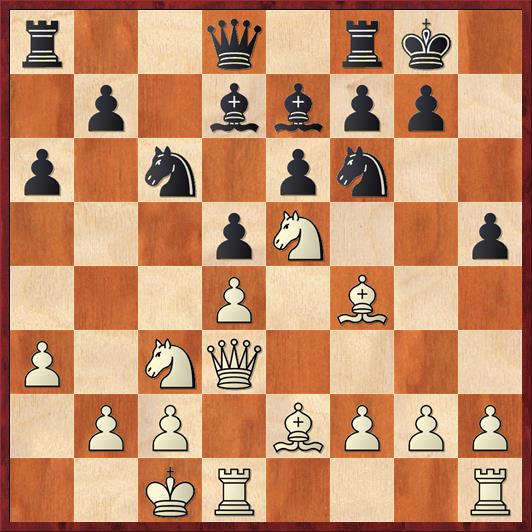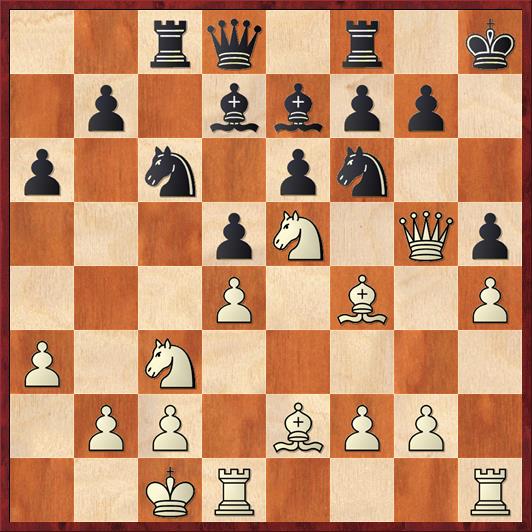Inspired by Eric Rosen’s victory in the London System in my last blog post, I decided to give it a try against the computer. And guess what happened? I won my shortest game ever against Shredder.
To be honest, the win had much more to do with Shredder’s awful play than my good play. Although I had its rating set at 2178, in this particular game it played one bad move after another. Still, there was one interesting position I’d like to show you.
 Position after 11. … O-O. White to move.
Position after 11. … O-O. White to move.
FEN: r2q1rk1/1p1bbpp1/p1n1pn2/3pN2p/3P1B2/P1NQ4/1PP1BPPP/2KR3R w – – 0 12
I had followed a somewhat similar plan to what Rosen did against Agdestein,with an early Ne5 and O-O-O. The computer has thrown in an early … h5, a move I considered to be nonsensical. But as a general rule I think one should not try too hard to “refute” this kind of flank advance in the opening. It’s best to just consider it a wasted tempo for Black and a future target for White.
Now that Black has castled kingside, though, that pawn becomes a much more immediate target. The moves I wanted to play here were 12. Qg3 or 12. Qh3. However, I decided that this would be a good time to take a time-out (I allow myself one time-out per game against Shredder).
The first thing I noticed was that 12. Qg3 or 12. Qh3 are both met rather effectively by 12. … h4! The idea is that after 13. Qxh4 Ne4, Black wins the exchange.
After that I looked at a variety of possibilities for White: my complete list of candidate moves was Qg3, Qh3, f3, h3, h4, Kb1, and Bg5. I came pretty close to playing 12. Bg5. Even though I lose a tempo by moving an already developed piece, it’s not so easy for Black to hold onto his h-pawn. The thing that finally decided me against this move was that I felt that in a line like 12. Bg5 b5 13. Bxf6 Bxf6 14. Nxc6 Bxc6 15. Bxh5, I was giving away my best pieces and my initiative merely for the chance to snatch a pawn.
The move I ended up choosing was 12. h4! Even though Rybka still says the position is roughly equal, I really like this move for a variety of reasons. First, it prepares Qg3 by taking away Black’s answer … h4. More generally, it fixes Black’s pawn weakness on h5 so that it can’t get away. It also controls the g5 square, which was important in some variations. Finally, it allows White to activate the one piece in his position that isn’t doing anything — the rook on h1. As I’ve written many times before, one of the key questions to ask yourself in strategic planning is, “What is my least effective piece and what can I do about it?” The rook can now lift to h3, where it is tremendously valuable for both defense (defending the knight on c3) and attack (moving to the g-file).
Shredder played 12. … Rc8, which I considered to be one of the two most likely possibilities (the other being 12. … b5). I replied 13. Qg3, which was my idea all along. The threat, of course, is Bh6, and if the knight moves to protect the g7 pawn, then the h5 pawn drops. Shredder played a clever defense that I had considered during my time-out, 13. … Kh8, which prevents Bh6. Now I played a risky move that I thought might be a blunder. However, I couldn’t find a refutation of it and I wanted to see what Shredder would do: 14. Qg5!
 Position after 14. Qg5. Black to move.
Position after 14. Qg5. Black to move.
FEN: 2rq1r1k/1p1bbpp1/p1n1pn2/3pN1Qp/3P1B1P/P1N5/1PP1BPP1/2KR3R b – – 0 14
This is a really tricky position. It looks foolish for White to put his queen on the same diagonal as Black’s e7 bishop, but Black has no way to take advantage of that because any knight move is immediately answered by Qxh5+. On the other hand, White’s threat to play Bxh5 next move is only a bluff. I can’t actually take that pawn because then the move Ne4 would be a strong answer. White’s real plan is Rh3-g3 or Rd3-g3, turning up the pressure on g7. Notice that Black would not be able to answer … Rg8 because of Nxf7+.
However, Black can forestall that threat and also create threats of his own with 14. … Nxe5, which is the move I expected. However, after either 15. de Rxc3?! or 15. de Bxa3?!, White wins a huge tempo with 16. ef!, threatening checkmate. This gives me the chance to have my cake (win the knight on f6 and the pawn on h5) and eat it too (taking the rook on c3 or the bishop on a3). Still, Black should have taken on e5 and followed up with … Nh7. After 14. … Nxe5 15. de Nh7!, 16. Qxh5 doesn’t even win a pawn because Black can play 16. … Bxa3. Best is 16. Qg3, with at best a minimal advantage to White, according to Rybka.
More aggressive options don’t work out for Black, like 14. … Qa5 15. Rh3! or 14. … Nxd4?! 15. Rxd4 Bxa3 16. ba Rxc3 17. Rh3!These variations show why White’s rook lift is so critical for defense as well as for attack.
Instead of playing any of these reasonable moves, Shredder lost its mind in the diagrammed position and played a really weak move that I never expected: 14. … Nb8? The goal, of course, is to open the c-file, but Black does so in a way that undevelops an active piece. Terrible, terrible. I played 15. Rd3 and Shredder followed up with the even worse 15. … Qb6??
 Position after 15. … Qb6. White to play.
Position after 15. … Qb6. White to play.
FEN: 1nr2r1k/1p1bbpp1/pq2pn2/3pN1Qp/3P1B1P/P1NR4/1PP1BPP1/2K4R w – – 0 16
Now how does White end the game?
If you said 16. Rg3, go to the head of the class! This simple tactic is an absolute gut punch. 16. … Rg8 would allow 17. Nxf7+. Knight moves allow either Qxe7 or Qxh5+. And 16. … g6 loses to 17. Nxg6+ fg 18. Qxg6 Rg8 19. Qh6+ and Black can resign here, because it’s a forced mate after 19. … Nh7 20. Be5+.
Ironically, even though this game was my fastest win ever against Shredder, I played too slowly here! I missed the crushing 16. Rg3 and played the cautious 16. Rhd1, making sure that the d-pawn is protected before moving the rook to g3. I think that I was “seeing ghosts.” Playing the computer too often will do that to you; you start thinking it has threats even when it doesn’t.
Fortunately, this move doesn’t really spoil anything, as White’s threats are still huge. In fact, Shredder could find nothing better than 16. … g6?, allowing me to break through with a smashing sacrifice: 17. Qh6+ Kg8? (One mistake after another. 17. … Nh7 fights harder, but the computer probably didn’t play it because 18. Bxh5! just picks off a pawn. If 18. … gh 19. Nxd5 Qd8 20. Rg3 Bf6 21. Nxf6 Qxf6 22. Ng6+ fg 23. Be5 skewers the queen and king.) 18. Nxg6! Qxb2+ (this queen giveaway doesn’t change anything) 19. Kxb2 fg 20. Qxg6+ resigns.
All in all, Shredder’s unusually feeble resistance made the last part of the game easier than it should have been. However, I was pleased with the maneuver 12. h4, 13. Qg3 and 14. Qg5, which posed the maximum possible difficulties for my computer opponent.
Even though the computer says the position after 12. h4 was equal, there is more to successful chess than the symbol “=” can convey. In some positions your opponent may be able to play practically any move. In others, he may have lots of choices but only one that works. The computer will tell you that both positions are equal, but the latter one is obviously a much better one to play.



{ 4 comments… read them below or add one }
Very well stated: “there is more to successful chess than the symbol ’=’ can convey.”
You’d think that “someone” is working on a chess program that gives analyses more relevant to human OTB players. Your metric (what fraction of the obvious moves are playable?) is a vital component. As well as metrics based on heuristics (presumably derived from actual play) on what kinds of moves/tactics are relatively easy/hard to see, as well as how deep into a branch the hard-to-see moves are.
Every position’s actual evaluation is either 1-0, 1/2-1/2, or 0-1. When a computer can’t see far enough to know which of these is the right answer, it gives an evaluation somewhere in the interior of [-?,+?], where it’s guessing based on its own heuristics (which I don’t know much about, and I’m sure are the proprietary secret sauces of each program). But those heuristics (materials and whatever else) aren’t all that well tuned to the reality of humans playing over the board, as your example of the equal position that is not at all equal shows.
Unfortunately, my \infty characters didn’t come through. Should have been: “ it gives an evaluation somewhere in the interior of [-infinity,+infinity],…”
Current evaluation (both human and computer) lacks a good way to talk about the difference between, say, an equal middlegame with a lot of play, and the endgame I had against a young prodigy two years ago where I not only could not find a way for either player to win, I couldn’t even find a way for either player to lose! (He played another 26 moves in this position, so I remember it vividly….)
This game does amusing things when you enter it into chess.com’s new strength-estimation system (which compares the evaluation of your moves with the computer’s) because I played 26 computer-perfect moves in a row–since the evaluation of all possible moves was the same (0.0).
“How many moves are there that are acceptable?” is not going to be a satisfying metric, I don’t think, because it drops to 1 in many positions where that one move is dead easy to find (I just played QxQ, you’d better play RxQ). “Hardness to find” is more difficult to quantify than objective strength because it’s a factor of human psychology which the machine does not necessarily share (though see Short-Timman for a great example of a plan that is hard for both humans and computers to find).
What I would really like from our silicon friends is the ability to explain *why* they think a move is good. I played one hyper-tactical Poisoned Pawn Winawer where at a key moment where I may be getting mated in the center the machine wants to play a5. I have never been able to figure out why.
Most of the good moves the computers want to play that we don’t understand are some kind of prophylaxis.